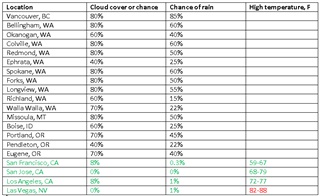
(In Russian. Scroll for English below)
Прохождение Венеры по диску Солнца -- необычное событие. Необычное и редкое: до этого года оно случалось лишь в 1882-м и 2004-м годах, а следующее ожидается уже в 2117-м. Я про всё про это прочитал ещё мелким пацаном лет 25 назад и с тех пор очень хотел увидеть это событие. Тем более, что в 2004-м прохождение в Америке не наблюдалось и 2012-й оставался последним шансом.
Готовиться я начал где-то за полгода. Прикупил 800-миллиметровую линзу, светофильтры, рассчитал экспозиции и тепловой режим съёмки.
План A был прост: снимать с побережья озера в Кёркланде. Если небо окажется затянуто тучами, то предполагался план B: выехать в пустыню по ту сторону гор и снимать с Rye Grass Rest Area. На крайний случай предусматривался план C: купить билет на самолёт и полететь туда, где погода окажется хорошей. Но это в теории.
Теория быстро обратилась в практику, когда сиэттловская погода развернулась к нам наиболее толстой частью своей серой задницы. Согласно прогнозу, сплошная лепёшка туч должна была накрыть весь северо-запад США в радиусе 1000 километров от Сиэтла!
На мой фейсбуковский клич отозвался Андрей Маренич, и за 4 дня до прохождения мы купили билеты до Лос-Анжелеса (точнее, до Long Beach), где к наблюдению готовилась также Константинова Мария. Предсказание погоды для района LA на тот момент было позитивным: "ясно", возможно, с "лёгкой облачностью".
За 20 часов до начала, подлетая к LA, я выглянул в окошко и матюгнулся едва ли не громче воющих двигателей: три четверти неба было затянуто тучами! Welcome to Seattle, ёпрст! Словно бы никуда и не летели!
В отеле мы с Андрюхой долго тыкались в предсказания погоды от специальных сервисов для пилотов, к которым Андрей имеет доступ. Результаты не обнадёживали, обещая в прилегающих к LA городах от 10% до 50% облачности. План C явно накрывался медным тазом, и в итоге был разработан план D: загрузить машину водой, хлестнуть по всем по двоим и выехать за горы в южной части страны где, по прогнозу, обещалось быть ясно. Целью был выбран городок Victorville.
Но реальность умудрилась пихнуть палки в колёса даже этому раскладу. Уже на полпути до пустыни, в автомобиле, Андрей проверил прогноз -- и выяснилось, что в Victorville тоже нагнало туч!
Тупик. Полный. Куда теперь ехать -- непонятно. Конечно, в идеале подходил Лас-Вегас -- но как туда попасть за 3 часа до начала представления?
И тут нам позвонила Маша. И сообщила, что вот у неё в Newport Beach всё как раз солнечно и ясно! Предсказатели погоды, правда, не очень с нею соглашались, но в равной степени они противоречили и друг другу, и сообщениям других друзей из LA. В условиях такого информационного хаоса я принял решение двигаться назад, в обсерваторию при University of Irvine, и смотреть оттуда. Тем более, что на крайний случай у нас ещё оставалось в обрез времени рвануть обратно в пустыню.
И мы поехали назад. Поначалу облака пугающе сгущались, но у самой обсерватории в небе вдруг образовался... просвет диаметром километров в 15, прямо над центром! И это нас спасло. К вечеру он расширился, а потом тучи ушли совсем, и мы не только прекрасно сфотографировали начало прохождения, но засняли также и закат, в промежутке отметив событие парой стаканчиков в местном ресторане :)
Результаты представлены ниже. Я же хочу сказать спасибо всем, кто нам помог и поддержал.
Спасибо Маше, Юле и Тане, воистину наколдовавшим нам хорошую погоду :)))
Спасибо Александре, любезно предоставившей запасную камеру.
Спасибо Андрею, и опять же Маше за способность бросить ради такого редкого события текущие дела и составить компанию в наблюдении!
Ну и огромное спасибо тем друзьям из Сиэтла кто, хотя и не смог поехать с нами, всё-таки в душе был с нами и нас поддерживал!
=============================================================
Venus transit is a spectacular and exceptionally rare astronomical event. The previous ones happened in 1882 and 2004; and the next one is in 2117. I've read about it over 25 years ago and since then wanted to see it. Unfortunately, the 2004 transit was not visible in America, so the 2012 one remained my last chance to see it.
I started my preparations 6 months ahead of time. Got an 800 mm mirror lens and a bunch of filters. Calculated all exposures and filtering needs, both optical and thermal.
Plan A was to shoot from Kirkland waterfront. For poorer weather, we had plan B to go to Rye Grass Rest Area in Eastern Washington where it's typically sunnier. Finally, there was a theoretical plan C to fly somewhere else if the weather turns out completely un-cooperating.
That theory had to be turned into practice as we've learned 4 days before the transit that there likely would be no single clear sky spot closer than 600 miles from Seattle!
I asked around on the Facebook, and Andrey Marenich kindly agreed to join me for the trip to LA. We decided to go the University of Irvine Observatory where Maria Konstantinova also planned to join us when we get there. At that time, weather forecast for the LA area looked very good.
But 20 hours before the transit I looked outside of our airplane's window approaching LA and almost screamed "Crap, welcome to Seattle!" 3/4 of the sky was covered by pretty thick layer of clouds.
I did not want to take chances, so upon arriving to the hotel Andrey and I developed plan D. It was to go to the desert on the East behind the mountains and shoot from there. We chose the city of Victorville as a target.
Next morning we packed several bottles of water, food, and took off to Victorville. However, even that plan did not get accomplished. As we drove, Andrey checked the forecast -- and guess what? It turned out that the clouds have moved to the east, and that it would've been "partially cloudy" even in Victorville!
At that moment, we really did not know where to go further. Well, Las Vegas would be an idea place, but how do you get there just 3 before the event?
That was the moment when Maria called us and told that at her place it was "all clear". Forecast services did not really agree to her, but so they disagreed to each other and to observations of other friends of us across the LA. So, in the lack of any more reliable information I decided to go back to the UCI. Worst case, we still had enough time -- barely -- to return to the desert.
And it worked! Well, at the beginning the clouds were getting denser and denser as we drove, but then suddenly a round hole some 8 miles in diameter has opened above our heads as we approached the Observatory -- and that was where we settled up 2 hours before the transit!
It all went well. The weather was so perfect that we've got pictures of the beginning of the transit, the sunset, and even had a chance to celebrate with couple margaritas in the middle :) The results are presented below -- take a look.
And at the end, I want to say Thank You to all who supported us in this undertaking.
Thank you Andrey and Maria for your recognition of the uniqueness of this moment and for accompanying myself to see this rare event.
Thank you Maria, Julia, and Tatiana for wishing us good weather :)
And thank you all our friends in Seattle and across the world who wished us a success in this story -- your thoughts came true!
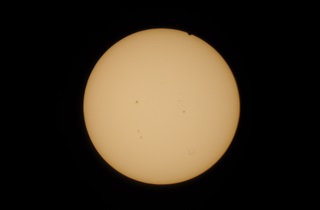
Начало прохождения. Чёрный кружок Венеры медленно наползает на Солнце чуть выше центра справа. Ближе к центру диска видны солнечные пятна.
This is the beginning of the transit. Venus just entered the Solar disk at the top right. In the middle, solar sports are seen.
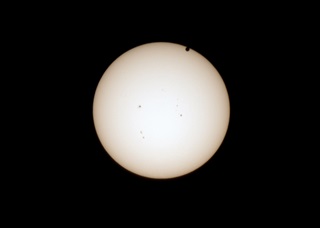
Спустя 11 минут (и в немного другой обработке).
In 11 minutes, Venus is almost entirely projected against the Sun.
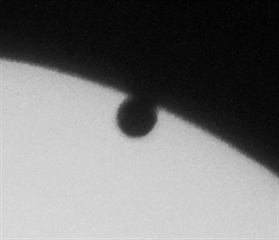
Увеличенный фрагмент предыдущего кадра. Теоретически, здесь вокруг части Венеры, ещё находящейся на тёмном фоне, должен наблюдаться эдакий тоненький светящийся ободок. Он образован "зарёй" солнечного света в венерианской атмосфере, которую именно так и открыл Ломоносов ещё в 1761-м году. Что вызывает немалое уважение, ибо я, несмотря на все старания, на своей 800-миллиметровой технике разглядеть эту "зарю" не смог. На более качественных снимках (например, от JAXA) она есть.
This is the enlarged fragment of the previous picture. Theoretically, a thin halo should be visible here around part of Venus still projected against the dark space. That halo is effectively a dawn on Venus, created by the sun light refracted in Venusian atmosphere and visible here on Earth. By seeing it in 1761, Russian scientist Mikhail Lomonosov deducted the existence of atmosphere on Venus. This is amazing, because even in 2012, with a powerful 800 mm lens, I still could not see it? However the halo indeed exists. You can see it on higher quality images (e.g., by JAXA).
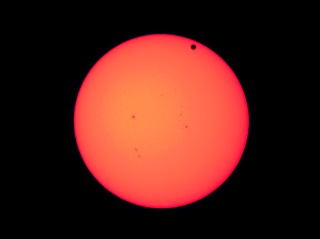
Съёмка через красный светофильтр дала слегка лучшие результаты.
Transit imaging through the red filter offered a slightly better resolution.
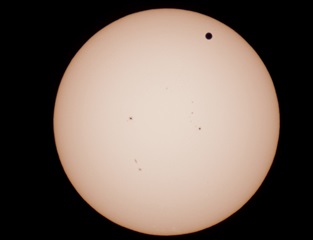
Один из присутствующих астрономов разрешил подсоединить камеру к его 1000-миллиметровому телескопу (F/10). Качество сей оптики оказалось отменным, что отчётливо заметно.
One of the astronomers watching the event kindly allowed me to connect my camera to his 1000-mm, F/10 telescope. The optics quality was amazing, offering this highly detailed picture.
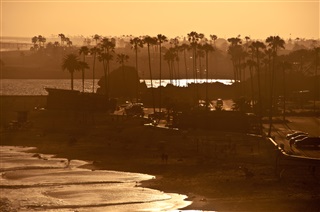
Сняв начало прохождения, мы запаковались, покинули обсерваторию, отметили успех мероприятия парой маргарит в Banderas, а затем спустились к морю, дабы поснимать закат и силуэт Венеры ближе к горизонту.
After shooting several pictures of transit's beginning, we packed, left the observatory, celebrated with couple margaritas at Banderas, and moved to the sea shore to shoot the transit closer to the horizon.
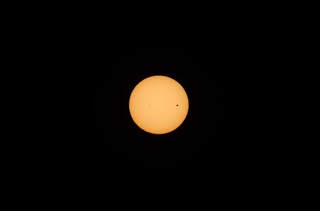
Некоторые скептики утверждали, что не было никакого смысла даже пытаться получить сколько-то интересный кадр прохождения Венеры, не имея специального и малодоступного астрономического оборудования. Дабы экспериментально проверить эти заявления, я сделал этот кадр. Здесь использована 200-миллиметровая линза с параметрами F/20, 1/4000, ISO 200, и 1000-кратный тёмный фильтр. Все эти вещи легко купить или арендовать. Вблизи горизонта при таких параметрах вполне можно безопасно фотографировать быстрыми "вскидками". Несмотря на относительно скромные параметры оптики, на кадре вполне видны как диск Венеры, так и солнечные пятна. Итак, я доволен, а скептики и лентяи опровергнуты :)
Some people said that it did not make sense even to try to make any informative picture of the transit without special and uncommon astronomical equipment. To test their predictions, I shot this picture at 200 mm, F/10, 1/4000 sec, ISO 200, through a 1000x neutral density filter. All these things are easy to purchase or rent. And since Venus was close to the horizon, quick aim-and-shoot pictures were totally safe to take. Result: even with relatively modest equipment, you can still get an image with the disk of Venus and the sunspots visible. Clearly something worth trying at least once!
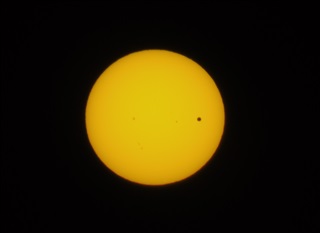
По мере приближения к горизонту качество изображения падает из-за рассеяния атмосферой.
As the Sun was setting, the quality of the image deteriorated due to atmospheric scattering and uneven refraction.
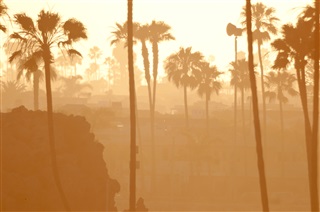
Пейзаж, снятый 800-миллиметровой линзой.
This landscape was pictured with an 800-mm lens.
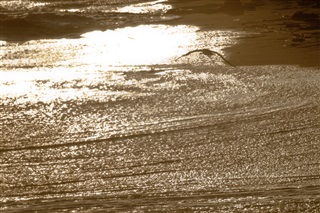
Тоже 800 мм.
Another one with 800 mm lens.
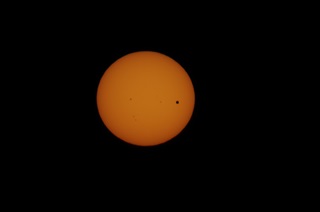
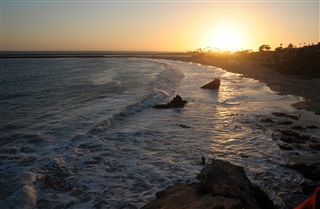
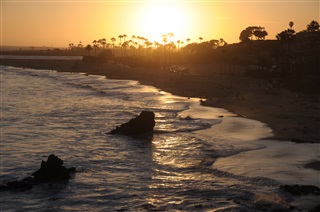
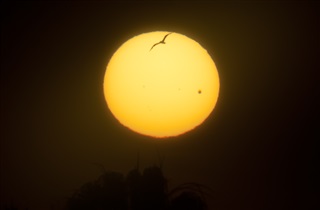
В порядке удаления: пальма, птица, Венера, Солнце. Его диск уже заметно сплющен атмосферной рефракцией.
The objects at this picture, in the order of their distance, are: a palm tree, a bird, Venus, and the Sun. Notice how visibly flattened it is by atmospheric refraction.
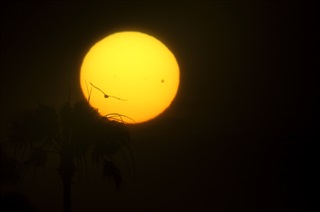
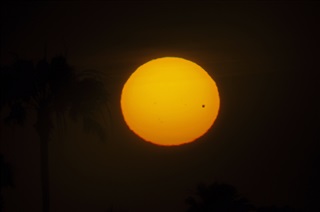
До заката считанные минуты. Я снимаю сквозь самодельный 25-кратный фильтр из покрытого фольгой пластика для заворачивания подарков :)
Several minutes before the sunset. I'm using a 25x filter here which I made myself of a piece of metal-covered gift wrapping plastic tissue :)
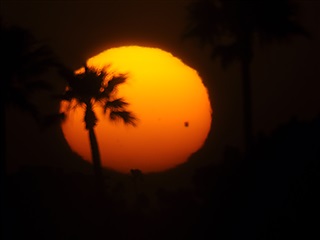
Непосредственно перед закатом. Солнце глядит на нас сквозь пару сотен километров воздуха. Видно, как преломеление через слои различной плотности искажает его очертания.
Just before the sunset. Now we are looking at the sun through some 150 miles of air. You can clearly see how severity the Sun's shape is distorted by refraction at multiple air layers with differing density.
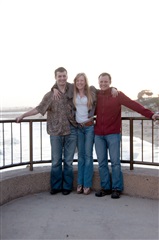
Я, Маша, Андрей.
Myself, Maria and Andrey.
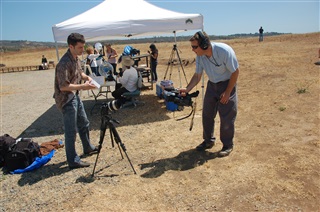
(Этот и последующие снимки выполнены Андреем Мареничем, любезно согласившимся поснимать обстановку на обсерватории, пока я был занят прохождением).
В данный конкретный момент я расставляю свою технику и даю интервью местной прессе :)
(This picture, as well as the remaining ones in this album, are made by Andrey Marenich who has kindly agreed to shoot the observatory surroundings while I was busy capturing the transit).
At this moment, I'm talking to the local press while setting up my equipment.
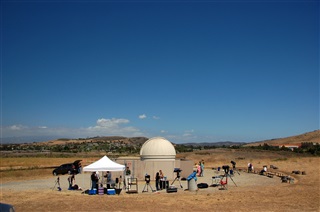
Обсерватория UCI минут за 15 до начала события. Почти пусто.
UCI observatory some 15 minutes before the transit. It's almost empty here.
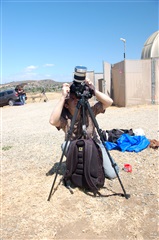
Ручная фокусировка в полупозе полураком (© фразы Александр Спешилов) была истинным мучением. Трудности усугублялись движением Солнца, покидавшим кадр за каких-то 2 минуты, и тепловым расширением линзы. Фокусировку приходилось постоянно подкручивать. Контролировать её качество на крошечном экранчике, залитом ярким сторонним светом, было тяжело даже с тёмной накидкой. В итоге 2/3 материала ушло в брак по нефокусу. К счастью, по предыдущим экспериментам с этой линзой я уже ожидал чего-то подобного и щёлкал с большим запасом :)
Manual focusing was pain. You had to adjust it continuously because of the Sun's visible motion (it stayed in the frame for 2 minutes only), and because of the lens thermal expansion. Controlling the quality of focus on the camera's screen was tough as well due to overwhelming ambient light, which I could not fully cancel even with improvised shade cover. As a result, approximately 2/3 of the frames had to be discarded due to poor focus. Fortunately, from my past experiments with this lens I knew to expect that so I was taking *a lot* of pictures to compensate for the losses :)
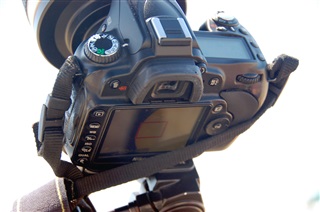
Вот так Солнце выглядело на экранчике.
This is how the Sun appeared at my camera's screen.
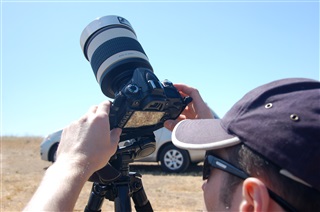
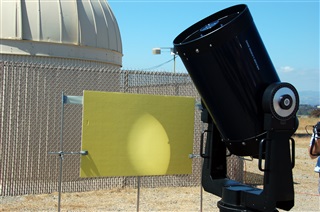
Проецирующий телескоп.
Projecting telescope.
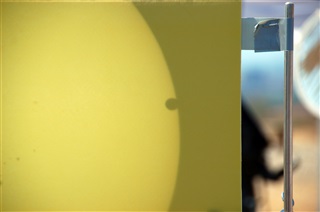
Результат проецирования. Кстати, на нём свечения атмосферы Венеры тоже не видно, что меня отчасти утешило :)
An image of Venus transit projected against a screen. Unfortunately, the halo of Venusian atmosphere was not visible here either.
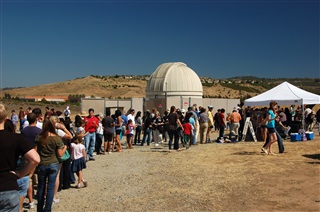
Где-то через час после начала прохождения народ начал подтягиваться толпами. Отрадно видеть такой интерес. Но несколько и грустно наблюдать опоздание, ибо самые интересные моменты прохождения -- это его начало и конец, а середина и впрямь довольно скучновата. И всё же люди заинтересовались, пришли, и это здорово!
About an hour after the onset of the transit dozens of visitors lined up at the observatory. I was happy to see so many people interested in this rare phenomenon. Unfortunately, they apparently did not know that the most interesting parts of the transit are the beginning and the end of it, with the middle being relatively boring indeed. Still, it was great to see to many spectators at this rare occasion.